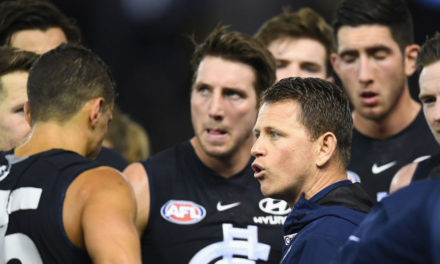Geelong in 2016 and Richmond last year were both “jumped” in preliminary finals after playing only one game in 27 days.
We talk a lot in AFL football about the competition being more even than ever, but what about when it comes to the most important part of the season, the finals?
When the stakes are at their highest, just how small, really, is the gap between a team which finishes on top of the ladder and one finishing seventh or eighth, perhaps half-a-dozen wins in arrears?
And if there is a sizeable difference in abilities and performance, should that alone be enough of an advantage for the higher-placed team, knowing one false move could end it all? Or having performed consistently better than nearly all its rivals from March until the end of August, does it deserve an easier run in the month which matters most?
As we prepare for another finals campaign, and a fourth year in which all eight finalists will enjoy a week off after round 23 to freshen up for September, they are questions worth keeping at the front of mind.
We already know that the best-performed team of the premiership season doesn’t always end up premier. In 29 completed seasons under the AFL banner, just nine times has the team which ended the home and away season on top ended up with the flag.
That says enough about the narrowness of the difference between the top few teams, and the entire competition for that matter, in the salary cap and drafting era.
Did it require further narrowing a few years ago in 2016 by the stroke of a legislative pen which introduced the pre-finals bye? Was that fair to the best-performed sides of a six-month AFL season? And how much of a difference has it actually made? We might be closer to a definitive answer on that in six weeks or so.
The final eight system was revamped in 2000, giving the top four teams a guaranteed double chance and all teams certainty about what a win or loss would mean.
And for the first 14 seasons of its operation, from 2000-13, there was one indisputable finals rule of thumb. That to even reach the penultimate week of the season and preliminary finals, a top four finish was essential.
Over that period, of 56 teams which played in a preliminary final, 54 of them had finished the home and away rounds top four, a strike rate of more than 96 per cent. The only two exceptions were Hawthorn in 2001and Collingwood in 2007, both of which had finished sixth and won their way through with victories in the elimination and semi-finals.
Were those numbers too lopsided? Not in my view. I think if you’re good enough across a 22-game season to finish top four, you deserve every benefit you get as a result.
But the pendulum of finals power has swung considerably since then, beginning in 2014, when both Port Adelaide and North Melbourne, which had finished fifth and sixth, got there, North Melbourne doing it again in 2015 from eighth, the Western Bulldogs from seventh in 2016, and last year Melbourne from fifth.
Of 20 preliminary finalists from 2014-18, only 15 had finished top four, or a strike rate of 75 per cent. Importantly, the pendulum was shifting even before the AFL introduced the pre-finals bye.
The main reason for that introduction cited at the time was to preserve the integrity of the final round of home and away games, after teams like Fremantle and North Melbourne, with their finals positions locked in, had rested up to half-a-side.
Given that we were talking about only a handful of 198 home and away games, I believed it was akin to cracking a walnut with a sledgehammer, risking not only diminishing the hard-won advantages of finishing top four, but potentially disadvantaging top four teams who won in week one.
The 2016 finals didn’t dispel that notion. That post-round 23 bye certainly assisted the seventh-placed Bulldogs, who were able to recover a clutch of injured key players, including Jack Macrae, Tom Liberatore, Easton Wood and Jordan Roughead – all of whom would have missed an elimination final in Perth without the benefit of an extra week off.
No, that doesn’t diminish the Dogs’ magnificent finals campaign, and they proved a very worthy premier. Whether they would have otherwise progressed beyond week one, however, remains a very valid question.
The new break didn’t appear to help Geelong much, though. The Cats, after finishing second, only missing top spot on percentage, had the week off, won their qualifying final against Hawthorn, had another week off, then lost the preliminary to Sydney.
On the day of its preliminary final, Geelong, after having played week in, week out for five months, had played just one game over a 27-day period. The Swans, who’d lost their qualifying final, were playing for a third week in a row. They duly jumped the lethargic-looking Cats with a seven-goals-to-nil opening term and it was as good as game over.
The AFL might have as happy as anyone about how the 2017 finals series panned out, then. It proved an effective enough rebuttal of those concerns, the top four all progressing to preliminary final weekend, and qualifying final winners Adelaide and Richmond winning their preliminary finals handsomely despite the shortage of competitive hit-outs.
Last year, you could argue in terms of the debate, was a 50-50 split. Melbourne reached a preliminary final from fifth spot, but the top three all making it through to the second-last weekend.
West Coast won a preliminary final coming off one game in 27 days and would go on to win an epic grand final. Richmond, though, a hot flag favourite after week one of September, and which like the Eagles had played one game in 27 days, was stunned by Collingwood in its preliminary final, down 10 goals to two by half-time and effectively beaten.
After three seasons of the new September arrangement, the results are inconclusive. What makes this season loom particularly large in providing a more definitive answer is the current shape of the contenders.
Right now, on form, it’s pretty hard to see any team outside the top four of Geelong, Brisbane, West Coast and Richmond upsetting the status quo.
The Cats have been on top of the ladder since round two. Brisbane, despite its novice finals status, has clocked up eight wins in a row. Richmond, having recovered a score of injured stars, has won seven straight. And the reigning premier has won seven of its past eight and lost the other game by a solitary point.
Beyond that quartet? Collingwood is still without a lot of injured talent, Greater Western Sydney is talented but erratic, Port Adelaide notoriously inconsistent, and Essendon has just lost two games by a combined 163 points, its 100-points-flogging at the hands of the Western Bulldogs one of the most embarrassing moments in its history.
Indeed, it’s the Dogs who could push as hard as any team from beyond the top quartet, having already done so in 2016, and currently playing a very dangerous brand. To sustain that for four straight games, however, against the best-performed teams in the competition, remains a huge task.
Importantly, too, the Bulldogs of 2016, whilst finishing seventh on the ladder, did so with 15 wins under their belt, the most by any side that low. This version would be taking on teams which may have won up to five more games.
Were it still 2013, you’d say the chances of anyone upsetting the top four’s apple cart were miniscule. Come 2014-15, you’d still argue it was a longshot. Post the introduction of the pre-finals bye, who really knows?
The nature of finals football is cut-throat and can be cruel. That’s exciting. Is it, though, an accurate reflection of the five months which preceded it? I suspect that with the extra week off, the answer “usually” has swung a little further towards “sometimes”.
And should that continue to be the case this September, whether that is actually desirable might be a question we hear being asked a bit more.
*This article first appeared at INKL.












The big problem with the pre-finals bye is it doesn’t benefit all teams equally, and we shouldn’t have something introduced that adds more inequality – even if it’s trying to fix another inequality (of only some teams being in a position to rest players wholesale before the finals).
Scrap it. Change the rules about resting players before the finals. It was obvious to all and sundry that Freo and North were resting players in in 2013 and 2015, so the AFL should tighten the rules allowed justifications for resting players. Just like they tightened the rules about rushed behinds in 2008, or deliberate out of bounds in whatever year that was.
The bye has definitely robbed Peter to pay Paul. Tho, maybe has robbed Patrick as well.
goo
An similar thing happened in soccer along these lines. Liverpool and Tottenham spent three weeks twiddling their thumbs before the Champions League final (Europe’s grand final) after their local English league finished.
Liverpool’s form had been hot but after three weeks without a game both teams could barely pass the ball anymore. The two nominally best teams in Europe played what was like a wonky pre season game of very low standard. Liverpool were just lucky to be playing a team in the same situation as them.